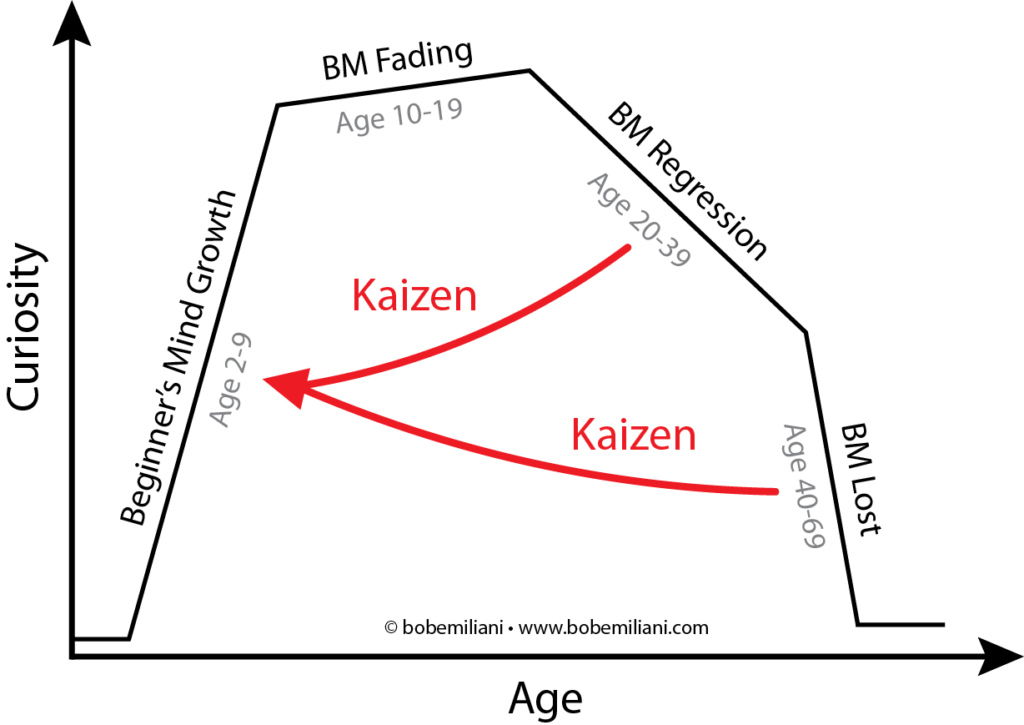Just about any person who has developed their creative capabilities to a high level will tell you the importance of looking at problems with a “beginner’s mind” (BM). Having a beginner’s mind means to free yourself of the preconceptions and social pressures that limit your thinking. It means to see everything for the first time.
Everyone had a beginner’s mind when they were a young child. But when children transition to adolescence, ages 10-19, they start to lose their beginner’s mind. After that, they are on a trajectory to completely lose their beginner’s mind.

Finding your beginner’s mind is a very difficult thing to do, but it is also necessary to do. For if we do not find our beginner’s mind, solutions to today’s problems will be the same as the solutions to yesterday’s problems. That will keep individuals, companies, and societies stuck, more or less, in the status quo.
How do you find your beginner’s mind? Be open-minded and curious. Is it that simple? For some people, yes, it is. For most others, no, it is not. Most people must engage in some form of deliberate practice to find their beginner’s mind. That can include thinking independently which will help you challenge preconceptions, your own or others’, careful observation, or practice mindfulness meditation. However, these are typically individual activities.
But there is one method that is wonderfully effective at helping people find their beginner’s mind — kaizen. But not just any kaizen; Toyota’s kaizen method, a team-based activity that helps people rediscover their beginner’s mind in tandem with developing their creativity coupled with teamwork. Toyota’s kaizen method is described in the books Shingijutsu-Kaizen and Kaizen Forever.
Importantly, it was the beginner’s mind generated via kaizen that created Toyota’s production system and later, the Toyota Way, including its subsequent evolution over the last 50 years. Kaizen is important far beyond most people’s understanding. Most people think it is just another “Lean tool.” It is not that at all.
It does not help that top Lean influencers do little to promote Toyota’s kaizen method. For example, James P. Womack goes on a lot of gemba walks. Invariably, he does not see anything close to Toyota’s management system in the companies that he visits. He does not see the creativity and innovation that is clearly evident at Toyota facilities. There is a reason for that: no kaizen, or no Toyota-style kaizen in those companies. Unfortunately, James P. Womack never thought much of kaizen and did almost nothing to popularize it. So I am not surprised he is disappointed with the state of Lean today.
You cannot make soup (a TPS-like management system) if you leave out the main ingredient, water. That is what kaizen is; the main ingredient. I do not think Jim Womack should be disappointed. What has been achieved reflects the lonstading point of emphasis* for the Lean Enterprise Institute: Lean tools, not kaizen.
It is only the way it is until we discover the new way it is, and then that is the way it is until we discover the new way it is, and so it goes…
Bella Baxter
SIDEBAR: Jim Womack says that the books The Machine that Changed the World and Lean Thinking gave people a proper system-level perspective. That is true. However, the former book mentioned the word “kaizen” only three times while the latter book mentioned the word “kaizen” numerous times but did not describe the method, its importance in finding the beginner’s mind and creativity, or its significance in creating the management system. Furthermore, the business of selling Lean — carried forth by the Lean Enterprise Institute — focused instead on selling Lean tool books and training courses since 1999. The Lean Enterprise Institute’s business of selling Lean tools eclipsed whatever system-level insight are contained in the two books.
